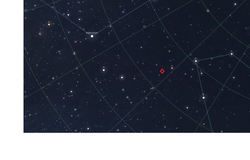HD 191939
 Location of HD 191939 in the night sky. The star is marked within the red diamond. | |
| Observation data Epoch J2000.0 Equinox J2000.0 (ICRS) | |
|---|---|
| Constellation | Draco |
| Right ascension | 20h 08m 5.75s[1] |
| Declination | +66° 51′ 2.1″[1] |
| Apparent magnitude (V) | 8.971[2] |
| Characteristics | |
| HD 191939 | |
| Evolutionary stage | main sequence |
| Spectral type | G8V[3] |
| Astrometry | |
| Radial velocity (Rv) | +9.266±0.0018[1] km/s |
| Proper motion (μ) | RA: +150.256[1] mas/yr Dec.: −63.909[1] mas/yr |
| Parallax (π) | 18.6247 ± 0.0253[1] mas |
| Distance | 175.1 ± 0.2 ly (53.69 ± 0.07 pc) |
| Absolute magnitude (MV) | 5.32 |
| Details[3] | |
| HD 191939 | |
| Mass | 0.92 M☉ |
| Radius | 0.945 R☉ |
| Luminosity (visual, LV) | 0.69 L☉ |
| Surface gravity (log g) | 4.44 cgs |
| Temperature | 5427 K |
| Metallicity [Fe/H] | −0.16 dex |
| Rotational velocity (v sin i) | 0.6 km/s |
| Age | 7±3 Gyr |
| Other designations | |
HIP 99175, TYC 4244-964-1, USNO-A2 1500-07227721, 2MASS J20080574+6651019, Gaia DR2 2248126315275354496, TOI 1339 | |
| Database references | |
| SIMBAD | data |
| Exoplanet Archive | data |
| Extrasolar Planets Encyclopaedia | data |
HD 191939 is a single yellow (G-type) main-sequence star, located approximately 175 light-years away in the constellation of Draco, taking its primary name from its Henry Draper Catalogue designation.
Characteristics[]
HD 191939 is a Sun-like G-type main-sequence star, likely older than the Sun and relatively depleted in metals.
Planetary system[]
In 2020, an analysis carried out by a team of astronomers led by astronomer Mariona Badenas-Agusti of the TESS project confirmed the existence of three gas giants,[3] all smaller than Neptune, in orbit around HD 191939. Another non-transiting gas giant planet designated HD 191939 e was detected in 2021, along with a substellar object on a highly uncertain, 9 to 46 year orbit.[4]
| Companion (in order from star) |
Mass | Semimajor axis (AU) |
Orbital period (days) |
Eccentricity | Inclination | Radius |
|---|---|---|---|---|---|---|
| b | 10.4±0.9 M |